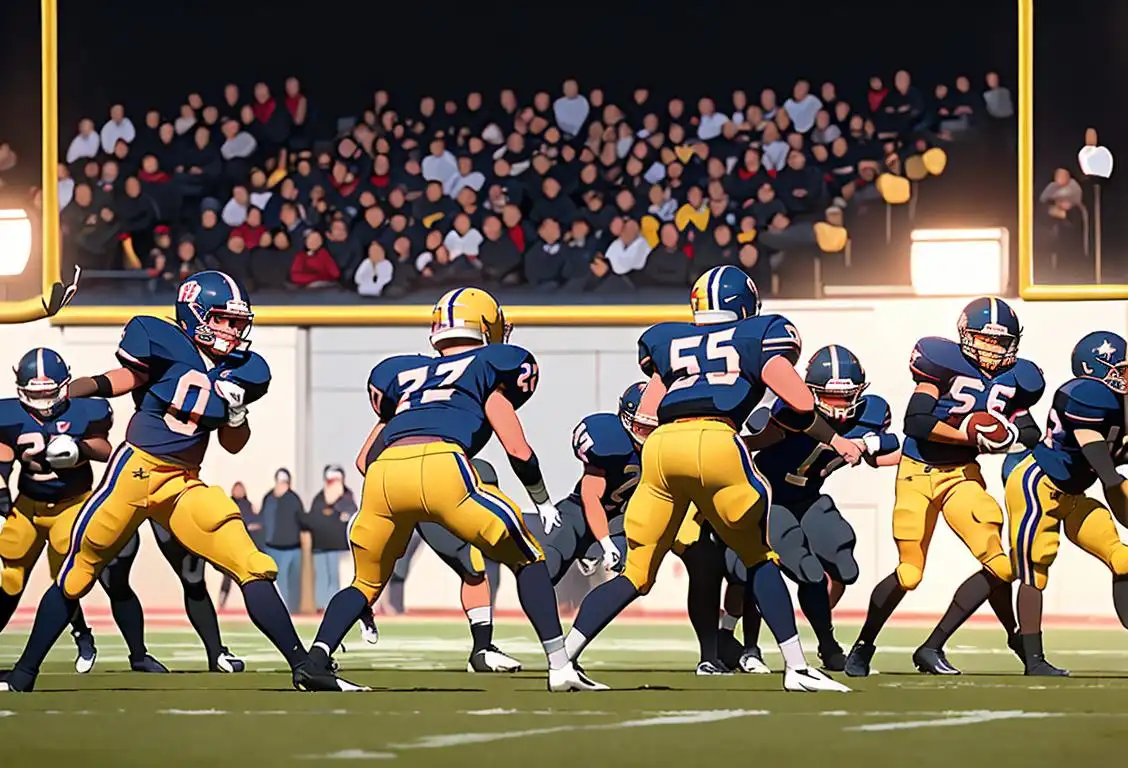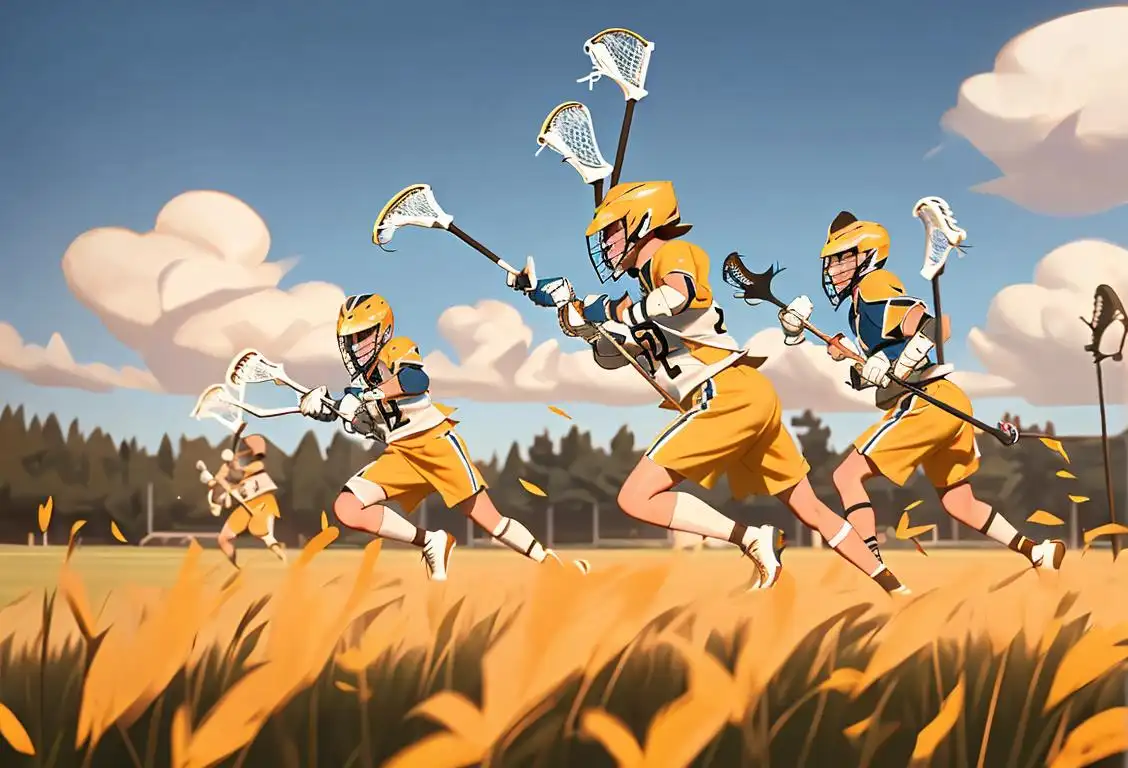National High School Football Day

Are you ready to tackle the excitement that comes with National High School Football Day? Grab your jerseys, put on your game face, and get ready for a touchdown of a celebration!
When is High School Football Day?
It's national high school football day on the 15th July.
The Touchdown of Internet History
Every year on September 29th, National High School Football Day celebrates the exhilarating sport that brings together communities, students, and passionate football fans across the nation. It's a day to honor the spirit of competition, teamwork, and school pride that can be found on Friday nights under those bright stadium lights.
High school football has a rich and storied history, merging athleticism, camaraderie, and good old-fashioned rivalries. It's that unique blend of heart-pounding action and unforgettable memories that has made it a beloved American pastime.
A Winning Tradition
The origins of high school football trace back to the late 19th century, when schools across the country began to form teams and play against each other. The game quickly grew in popularity, captivating audiences with its fast-paced nature and thrilling moments. Soon, high school football became a beloved tradition in communities, with fans flocking to stadiums to cheer on their local heroes.
Over the years, high school football has evolved into a cultural phenomenon. It's not just about the game itself, but about the lasting friendships formed, the lessons learned, and the cherished memories created on and off the field. National High School Football Day serves as a reminder of the impact this sport has on players, students, families, and communities.
A Day of Celebration
On National High School Football Day, schools, teams, and fans come together to celebrate the sport and show their support. From pep rallies to tailgate parties, the day is filled with excitement and anticipation for the Friday night lights. Communities join forces to honor their local teams, coaches, and players, recognizing their hard work, dedication, and accomplishments.
Whether you're a current or former player, a fan in the stands, or someone who simply appreciates the spirit of high school football, this is the day to come together and celebrate all that makes this sport special.
History behind the term 'High School Football'
1869
Birth of American football
In 1869, American football was born when the first game between Princeton University and Rutgers University was played. This marked the beginning of organized football in the United States.
1869
The Birth of American Football
In 1869, the first intercollegiate football game was played between Rutgers and Princeton. This laid the foundation for American football as we know it today. The game quickly gained popularity among colleges and universities across the United States.
1869
The Birth of American Football
American football was born in 1869 when the first documented game between colleges was played. This game took place between Rutgers and Princeton, and it laid the foundation for organized football in the United States.
1869
The Birth of College Football
In the year 1869, the first intercollegiate football game took place between Rutgers and Princeton. This event marked the birth of organized football in the United States. As the popularity of college football grew, it began to influence the development of football at the high school level.
1869
Inception of American football
American football was first played in 1869 between Rutgers and Princeton. At this time, football was a college sport, and did not have any connection to high schools.
1869
Inception of American football
American football originated in 1869 when the first `American football game`_ was played between Rutgers University and Princeton University. The game was a variation of soccer and rugby, with each team consisting of twenty-five players. However, there were no high schools involved in football at this time.
1869
The First College Football Game
On November 6, 1869, Rutgers College and the College of New Jersey, now known as Princeton University, played the first ever game of intercollegiate football. This match marked the beginning of organized football in the United States, but it would be several years before the term 'high school football' came into existence.
1869
The birth of American football
The term 'high school football' can be traced back to the birth of American football in 1869. This was the year when the first documented game between two college teams, Princeton University and Rutgers University, took place. It marked the beginning of a new era for football in the United States, laying the foundation for the sport's future popularity.
1881
The Emergence of High School Football
High school football emerged as a result of the growing popularity of the sport at the college level. Inspired by collegiate games, high schools across the country began organizing their own football teams to compete against each other.
1880s
The Emergence of High School Football
During the 1880s, American high schools began adopting the sport of football as a way to promote physical fitness among students. The game provided an opportunity for young individuals to showcase their athletic abilities and fostered a sense of school pride and competition. It started with small-scale matches between neighboring high schools, gradually gaining recognition and support.
1880s
Growth of High School Football
During the 1880s, football gained popularity at colleges across the country. As a result, many high schools began adopting the sport as a way to promote physical education and school spirit. The early high school football teams played mostly against each other and local clubs rather than against other high schools.
1880s
Incorporation of football in high schools
During the 1880s, football became increasingly popular among high schools across the country. As the sport gained popularity, it started being played by students in educational institutions as a way to promote physical fitness and school spirit.
1875
Establishment of the first public high school
In 1875, the first public `high school`_ in the United States, Boston English High School, was established. This marked the beginning of a new era in education, providing secondary education to a wider population. High schools gradually gained popularity, leading to the inclusion of sports like football as extracurricular activities.
1880s
Introduction of football in secondary schools and academies
During the 1880s, football gained popularity and started being played in secondary schools and academies. This was the first instance of football being associated with education institutions beyond colleges.
1887
Introduction of Football in High Schools
In 1887, the sport of football was introduced to high schools in the United States. It was primarily played by students who had already participated in college-level football or had been inspired by the growing popularity of the sport. High school football teams often formed as extracurricular activities.
1880s
Football finds its way to high schools
In the 1880s, American football began to make its way into high schools across the country. As the sport gained popularity at the college level, schools recognized its potential as an engaging and competitive activity for their students. High schools started forming their own football teams, which led to the emergence of 'high school football' as a distinct term.
1890
The Formation of Interscholastic Associations
In 1890, the first interscholastic football association, the Massachusetts Interscholastic Athletic Association (MIAA), was formed. This association aimed to standardize the rules and regulations for high school football and promote fair competition among schools.
1892
The birth of interscholastic football
In 1892, the first recorded interscholastic football game took place between Bloomington High School and Normal High School in Illinois. This marked a significant turning point for high school football, as it became a formalized sport with organized competitions between schools. The term 'high school football' gained further prominence as more schools adopted the sport.
1892
The Founding of the National Federation of State High School Athletic Associations
In 1892, the National Federation of State High School Athletic Associations (NFHS) was established. This organization aimed to standardize rules and regulations for high school sports across different states, including football. The NFHS played a crucial role in the development and organization of high school football tournaments and championships, creating a platform for talented young athletes to shine.
1893
Formalization of High School Football
The year 1893 saw the formalization of high school football rules and regulations, which were standardized in order to establish fair competition among schools. Michigan was the first state to officially organize a high school football association and introduce a postseason championship.
1890
Creation of the first high school football league
In 1890, the first official high school football league, known as the Scholastic League of New York City, was established. This marked the beginning of organized high school football.
1883
First High School Football Game
In 1883, the first recorded high school football game took place between Eton College and Rugby School in England. This event sparked interest in high school football and further contributed to its growth as a competitive sport.
1880
Introduction of interscholastic football
The concept of interscholastic sports, including football, emerged in the late 19th century. In 1880, the first recorded interscholastic football game took place between `Phillips Exeter Academy`_ and `Phillips Academy`_. This marked the start of high school football as a competitive sport between different institutions.
1892
First recorded high school football game
On November 6, 1892, the first recorded high school football game took place between Germantown High School and Central High School in Philadelphia, Pennsylvania. This marked a pivotal moment in the history of high school football as it demonstrated the spread of the sport to the younger generation.
1892
Formation of the National Federation of State High School Athletic Associations
In 1892, the `National Federation of State High School Athletic Associations`_ (NFHS) was established with the goal of standardizing rules and regulations for high school athletics, including football. This organization played a vital role in the growth and development of high school football, ensuring fair competition and safety guidelines.
Early 1900s
Rise in popularity of high school football
In the early 1900s, high school football grew in popularity. More and more schools began forming teams and scheduling games against other schools. The competitive nature of the sport led to fierce rivalries and created a sense of community spirit among students, parents, and the local community.
1903
The Rise of State Championships
In 1903, the first official high school football state championship was held in Ohio. This marked the beginning of state-level competitions, where the best high school football teams from each state would compete for the title of state champion.
1903
Formation of national high school football organizations
In 1903, two national high school athletic organizations were established: the National Federation of State High School Athletic Associations (NFSHAA) and the National Interscholastic Athletic Association (NIAA). These organizations aimed to standardize rules, regulations, and competitions for various high school sports, including football. Their formation helped solidify the popularity of 'high school football' as a distinct entity.
1903
Formation of National Federation of State High School Athletic Associations (NFHS)
The NFHS was formed in 1903 as a governing body for high school sports, including football. This organization ensured standardization and uniform rules across different states, leading to the development of high school football as we know it today.
1920s
Rise of High School Football Popularity
By the 1920s, high school football had become immensely popular, drawing huge crowds of spectators to support their local teams. The game became deeply ingrained in the American culture, with communities rallying around their high school teams, creating fierce rivalries, and dedicating Friday nights to attending football games. High school football became a symbol of community spirit and provided a source of entertainment and unity during challenging times.
1903
Popularity Explosion
In 1903, the popularity of high school football skyrocketed as more schools across the United States established teams and competitions. The sport gained immense support from communities, becoming a major source of entertainment and school pride. Excitement surrounding Friday night games became a cultural phenomenon.
1892
Creation of the National Federation of State High School Associations
In 1892, the National Federation of State High School Associations (NFHS) was established in the United States. The NFHS aimed to standardize rules and regulations for various high school sports, including football. This organization played a significant role in the development and organization of high school football nationwide.
1903
Inception of organized state championships
In 1903, the state of Illinois became the first to hold an organized high school football state championship. This event set a precedent, and soon other states began organizing their own championships. State championships added excitement and prestige to high school football, leading to increased participation and fan interest.
1930s-1940s
Impact of High School Football on Education
During the 1930s and 1940s, high school football experienced a significant impact on education. Schools recognized the positive influence of sports on student engagement and academic performance. High school football programs expanded, and many educational institutions invested in better facilities, coaching staff, and resources to support their teams. Football scholarships also became a means for talented student-athletes to pursue higher education opportunities.
1914
First national high school football championship
The first national high school football championship game took place in 1914. This event showcased the growing popularity and significance of high school football across the United States.
1920s
Formation of Regional Leagues
During the 1920s, regional high school football leagues began to form, allowing schools to compete against each other on a regular basis. These leagues provided a structured framework for scheduling games and helped foster rivalries between schools, contributing to the excitement and popularity of high school football.
1920s
Rise in popularity and community spirit
During the 1920s, high school football experienced a significant rise in popularity. The sport became a focal point for communities, with passionate fans rallying behind their local teams. High school football games became major social events, attracting large crowds and fostering a sense of community pride. The term 'high school football' became synonymous with this cultural phenomenon.
1910
The Advent of National Rankings
In 1910, the first national high school football rankings were introduced by the National Sports News Service. These rankings helped create a sense of nationwide competition and provided recognition for exceptional high school football teams.
1910
Adoption of Protective Equipment
Concerns over player safety led to the adoption of protective equipment in high school football. In 1910, leather helmets were introduced to provide some level of head protection. This step towards player safety helped alleviate fears and allowed the sport to continue growing.
1930s
Integration of high school football
During the 1930s, high school football started becoming more inclusive with the integration of racially segregated teams. Some regions had already integrated their teams earlier, but it wasn't until this period that integration became more widespread. This step marked an important milestone in the fight for equality within the sport.
1930s
Broadcasting and Media Coverage
In the 1930s, high school football started receiving increased media coverage, particularly through radio broadcasts. This exposure allowed fans from all over to follow their favorite high school teams and players, further fueling the growth and fanaticism surrounding the sport.
1950s
Television coverage of high school football
In the 1950s, high school football games began receiving television coverage. This propelled the sport even further into the public eye, enhancing its popularity and giving local communities the opportunity to showcase their teams on a wider scale. Television coverage also provided exposure for talented high school players, catching the attention of college recruiters.
Present Day
Continued Legacy of High School Football
High school football remains a prominent part of American culture and continues to thrive in the present day. It serves as a platform for young athletes to showcase their skills, learn important life lessons such as teamwork and discipline, and build lasting friendships. The sport unites communities, fosters school pride, and provides entertainment and excitement for millions of fans each year. High school football has an enduring legacy and occupies a special place in the hearts of many Americans.
1937
The Birth of Friday Night Lights
The widespread adoption of floodlights in stadiums during the 1930s allowed high school football games to be played on Friday nights. This tradition, known as "Friday Night Lights," became immensely popular, drawing large crowds to support their local teams.
Present day
Continued cultural significance
Today, 'high school football' remains a vital part of American culture. It continues to be widely played, loved, and celebrated across the country. High school football rivalries and championships draw immense attention and support from communities. The term has transcended its origins to represent more than just a sport, symbolizing the spirit, camaraderie, and traditions associated with high schools.
1930s
Integration of African American Players
The 1930s witnessed the integration of African American players into high school football teams. Despite facing significant racial barriers, several talented African American athletes emerged as stars on the field, showcasing their skills and challenging discriminatory practices.
1905
Creation of the National Football Federation
In response to concerns about player safety and growing injuries in football, the `National Football Federation`_ (NFF) was formed in 1905. The NFF aimed to address these concerns by implementing safety measures and rule changes. This organization played a crucial role in improving the game and ensuring the well-being of high school football players.
1972
Title IX and Gender Equality
In 1972, Title IX of the Education Amendments was passed, ensuring gender equality in educational programs. This legislation had a significant impact on high school football, as it paved the way for the development of girls' football programs across the United States.
2018
Present Day
Today, high school football holds a prominent place in American culture. The sport attracts large crowds, garners media attention, and serves as a platform for young athletes to showcase their skills. It continues to foster a sense of school pride and community spirit, becoming an integral part of the high school experience for many students.
1917
Popularity surge during World War I
During World War I, high school football gained immense popularity in the United States. With many young men enlisting in the war, the game became a symbol of patriotism and resilience. High schools organized fundraisers and charity games, contributing to the war efforts and boosting enthusiasm for football.
Present day
Continued tradition and glory
High school football remains a cherished tradition in many communities across the United States. It is deeply ingrained in American culture, with Friday night games drawing enthusiastic crowds to cheer on their local teams. Today, high school football plays a significant role in fostering team spirit, teaching discipline and leadership skills, and creating lasting memories for players and fans alike.
1945
Post-WWII Growth
Following World War II, high school football experienced a surge in participation and fanfare. The end of the war brought communities together, and football provided a sense of unity and normalcy. This period marked the growth of high school football into a true cultural phenomenon.
1970s
Media Coverage Expansion
During the 1970s, high school football began receiving increased media coverage. Local newspapers and radio stations started reporting on games, and televised broadcasts of high school football championship games became more common. This attention further solidified the sport's popularity.
1930s
Integration of high school football
In the 1930s, high school football witnessed a significant turning point with the inclusive integration of schools. African American students were previously excluded from participating in interscholastic sports, but this began to change during this period. Integration brought newfound talent and diversity to the game, showcasing the power of sports in fostering equality.
2006
High School Football Goes Digital
With the advent of the internet and digital technologies, high school football gained even more exposure. Websites, live streaming, and social media platforms allowed fans to follow their favorite high school teams and players, further fueling the excitement and community spirit surrounding the sport.
1971
Title IX and gender equality
The passage of Title IX in 1971 revolutionized gender equality in high school sports, including football. Title IX mandated equal opportunities for female athletes, leading to the establishment of girls' football teams. Although still less widespread than boys' teams, girls' high school football continues to grow, inspiring young girls to pursue their passion for the game.
Present
Thriving tradition and community support
High school football has become deeply ingrained in American culture, particularly in small towns and suburban areas. Friday night football games are a longstanding tradition, bringing communities together and fostering a sense of pride. The passion for high school football continues to thrive, with dedicated players, passionate fans, and spirited rivalries.
Did you know?
Did you know that high school football is often a stepping stone for talented athletes looking to pursue a career in college or professional football? Many NFL stars got their start playing under those Friday night lights!Tagged
fun community sportsFirst identified
23rd September 2016Most mentioned on
15th July 2017Total mentions
46Other days
High School Football Day
Hockey Card Day
Lacrosse Day
Teams Day
Walking Day
Cancer Survivors Day
Rum Day
Memorial Day
Jr Smith Day
Dance Day








